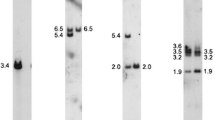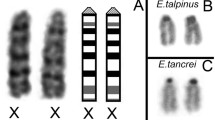Summary and Conclusion
-
1.
In the Chinese hamster, a species of Eurasian Cricetinae, the Y-chromosome is almost as large as the X: both have long arms approximately equal in length.
-
2.
During male meiosis when the major portion of the X and Y are heavily condensed, the distal two-thirds of the long arms of both the X and Y remain isopycnotic and serve as pairing segments which permit side-by-side association. Coincident with condensation of the sex chromosomes at first meiotic prophase, the smallest (tenth) autosomal bivalent also manifests positive heteropycnosis.
-
3.
Matthey believes that the large Y seen in many species of Eurasian Cricetinae results from a translocation involving a small Y, a large X, and a homologous pair of autosomes. This hypothesis explains our present observations on the Chinese hamster.
-
4.
Side-by-side pairing of the X and Y during male meiosis is limited to those very few mammalian species in which the unusually large Y diminishes the size difference between the sex chromosomes. Available evidence indicates that this rare situation results from a translocation with the autosomes.
Similar content being viewed by others
References
Hamerton, J. L.: Mammalian sex chromosomes. In Symposium on Nuclear Sex, p. 25–28. New York: Interscience Publ. 1958.
Matthey, Robert: Cytologie comparée des Cricetinae paléarctiques et américains. Rev. suisse Zool. 68, 41–61 (1961).
Ohno, S., W. D. Kaplan and R. Kinosita: A photomicrographic demonstration of mitosis and meiosis in the male of Rattus norvegicus. Cytologia (Tokyo) 23, 422–428 (1958).
—, W. D. Kaplan and R. Kinosita: On the end-to-end association of the X and Y-chromosomes of Mus musculus. Exp. Cell Res. 18, 282–290 (1959).
—, W. D. Kaplan and R. Kinosita: Basis of nuclear sex difference in somatic cells of the opossum, Didelphys virginiana. Exp. Cell Res. 19, 417–420 (1960).
- C. Stenius, C. Weiler, J. Trujillo, W. D. Kaplan and R. Kinosita: Early meiosis of male germ cells in fetal testis of Felis domestica. Exp. Cell Res. (in press).
—, and C. Weiler: Sex chromosome behavior pattern in germ and somatic cells of Mesocricetus auratus. Chromosoma (Berl.) 12, 361–373 (1961).
Sachs, L.: Sex linkage and the sex chromosomes in man. Ann. Eugen. (Lond.) 18, 255–261 (1954).
Tjio, J. H., and A. Levan: Notes on the sex chromosomes of the rat during male meiosis. Anales Estac. Exp. Aula Dei 4, 173–184 (1956).
Yerganian, George: Chromosomes of the Chinese hamster, Cricetulus griseus. I. The normal complement and identification of sex chromosomes. Cytologia (Tokyo) 24, 66–75 (1959).
Yerganian, George, R. Kato, M. J. Leonard, H. J. Gagnon and L. A. Grod-Zins: Sex chromosomes in malignancy, transplantability of growths, and aberrant sex determination. In Cell Physiology of Neoplasia, p. 49–96. Austin: University of Texas Press 1960.
Author information
Authors and Affiliations
Additional information
This work was supported in part by Grant C-5138 from the National Cancer Institute, U.S. Public Health Service.
The authors acknowledge with gratitude the editorial assistance of Patricia A. Ray.
Rights and permissions
About this article
Cite this article
Ohno, S., Weiler, C. Relationship between large Y-chromosome and side-by-side pairing of the XY-bivalent observed in the chinese hamster, Cricetus griseus. Chromosoma 13, 106–110 (1962). https://doi.org/10.1007/BF00349622
Received:
Issue Date:
DOI: https://doi.org/10.1007/BF00349622




